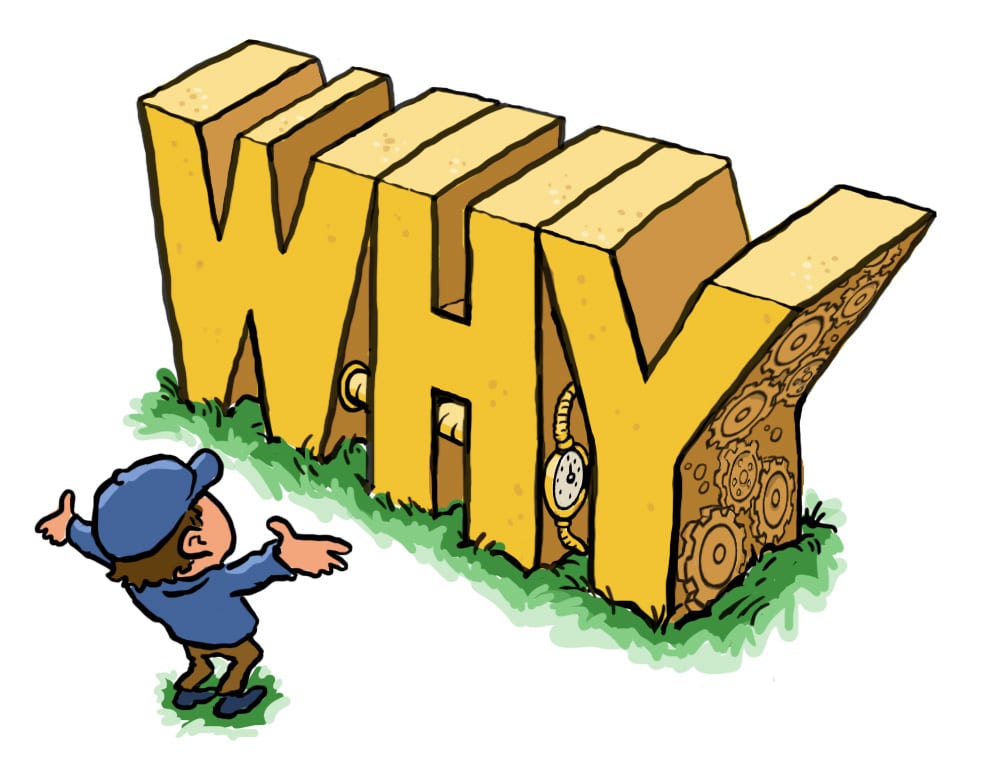In 2018, one of the world’s leading tool brands asked me to come to train their teams on innovation. While I have a robust history of teaching innovation across a variety of industries, I am the first to admit that my knowledge of tools is a bit underwhelming. With my work and travels, I’ve just never found the time to be one of those DIY-types.
Wanting to understand the tool market a little bit better before I gave my talk, I decided to spend a weekend observing my client’s core customers. And what better place to observe customers than at the point of purchase? I wanted to see that moment where thought turns to action, and people open their wallets to exchange their hard-earned dollars for the promise of a particular brand.
Walking into my local DIY store on a busy Saturday morning, my eyes immediately took note of the huge number of young couples, the HGTV-types who just bought a fixer-upper and are ready to roll up their sleeves and get to work. While I had always thought of home improvement stores as a place for burly contractors and dads buying yet another tool for their collection in the garage, it was clear that the tides of the market were changing. And like many industries, this shift was being driven by Millennials and Gen Z.
I began wandering the aisles, watching these young couples evaluate shelf after shelf of tools, eventually selecting what they believed to be the perfect one for the job. Hoping to collect insights on what these consumers thought of my client’s brand, I was quickly disappointed upon discovering that this particular group of Millennial and Gen Z consumers didn’t really seem to care much at all about my client’s products.
Needless to say, I was deeply concerned for my client. Why weren’t they connecting with these consumers? Was their brand inferior? Were they not advertising in the right channels? I needed to get to the bottom of this.
I decided to continue my observation, visiting several more Home Depot and Lowe’s locations in the area. Store after store, these trends continued. No matter where I was, the customers didn’t seem to pay much attention to my client’s brand. In fact, it quickly became evident that these young couples didn’t seem to care about any tool brand.
As I listened in on the pre-purchase conversations taking place, there was never a discussion about which tool would “drill the fastest” or “hammer the hardest.” They never discussed the brand, the product features, or even the price. Instead, these couples focused solely on the purpose behind the tools: building their dream home.
At that moment it struck me: this tool company didn’t need more products or better features.
They needed a better purpose.
Armed with a newfound insight, I made the trip to the tool manufacturer’s headquarters several weeks later. Sitting down with their Executive Team, I was excited to hear about their plans for innovation and to talk about their driving purpose. Surely, they knew that their customer base was evolving, and were hard at work on strategies to match the changing needs.
Unfortunately, what I heard next was nothing more than a list of profit-chasing strategies: Cost-reduction. Outsourcing. Expansion into growing Latin American markets. Iteration, not innovation. It was clear that the captain of this brand’s ship was quarterly financial results.
While I understand the need to set goals and hit targets, this can no longer be the primary driver of your business, as it will eventually cause you to be left behind. Chasing quarterly metrics is what led the Sears and the Blockbusters of the world to miss the next wave of innovation, ultimately driving them out of business.
Latin American expansion might give this tool conglomerate another 3-5 years of profit growth, but what happens after that? A few years ago, we all got a glimpse of the first 3D printers, which would take several hours to print out a small trinket. Today, there are companies printing 3D houses in a matter of hours. What happens 10 or 20 years from now? Might consumers be able to print any tool they need on demand at home? Or do you even need tools if you can print a coffee table or bookshelf at the 3D print shop down the street? What sort of effect will this have on the tool companies of the world?
Undeterred, I began to explain my observations to these tool Executives. I told them about the young Millennial and Gen Z DIY couples and how their discussions focused not on their tools, but on their dream home, and how features and price points were barely mentioned, opting instead to talk about how the updates to their home would make them feel: what it would be like to settle in and enjoy their new living space; how their sparkling new kitchen would be a point of pride when having guests over for dinner.
I made it clear that the long-term success of their business depended on their purpose, not short-term profit.
I asked these executives to think about their company’s purpose. Was it to make a quality tool? Reward shareholders with a nice dividend? Routinely hit quarterly targets?
What if instead of being just another tool company, iterating new tool after new tool with marginal benefits, their purpose was to “help people build their dreams”?
What a noble purpose for a tool company! A company that helps people build their dreams is no longer “just a tool company,”, and as such, is no longer at risk of going extinct if and when tools become obsolete. Think about how elastic this brand could become if their purpose is to help people build their dreams. They could create furniture and décor accessories for the dream homes they help build. They could become an alternative lender to help more people afford their dream homes. And even beyond that, they could help families have dream vacations through a line of innovative hotels, or help kids have the holidays of their dreams by manufacturing toys. The possibilities are endless!
By leading with a strong purpose, this company opens up an endless world of opportunity for themselves.
And here’s the best part: when done correctly, building a brand around purpose does not have to come at the expense of profit. In fact, it can help you become one of the most profitable companies of all time!
Take Ford, for example. Henry Ford knew that America was a land full of explorers, a country populated with immigrants and descendants of immigrants that braved treacherous oceans and incredible hardships to explore the vast land between America’s coasts. With this in mind, he didn’t start The Ford Motor Company to simply make and sell cars. He started it as a means to provide adventure and exploration to the American people. With his Model T, you could travel further and explore more of America than ever before.
Ford’s purpose wasn’t to build cars. It was to connect America. And this purpose of connecting America is what allowed Ford to overtake thousands of independent car manufacturers in a few short years and become the clear leader in the automobile industry.
Same for Apple, the world’s first company to hit a trillion-dollar valuation. Steve Jobs famously said:
“Apple is about people who think ‘outside the box,’ people who want to use computers to help them change the world, to help them create things that make a difference, and not just to get a job done.”
Nowhere in there does it talk about profitability benchmarks or quarterly targets. Apple has always been clear: we make things for people that think and act differently. That’s our purpose. And if this aligns with your own purpose, chances are you’re reading this post on an Apple product.
As Simon Sinek stated in his Ted Talk and groundbreaking book Start with Why, “People don’t buy what you do, they buy why you do it.”
Yet many brands still work backwards. They approach everything with a “profit-first” mentality, determining which parts and features can drive costs down the most and capture the largest profits. And while this strategy may have worked for some period of time in some industries, that window is closing rapidly.
Millennials and Gen Z have made it abundantly clear: we’re interested in why you do what you do. We care more about what you stand for as a brand than we do about the specs and features.
Walt Disney, an incredibly successful entrepreneur, did not create Disneyland as a vehicle to become the world’s most valuable entertainment company. He did not envision his park as a means to sell t-shirts and Mickey Mouse ice cream bars. On the contrary, the purpose behind Walt’s iconic park was simple: create a place where families can have fun together. In Walt’s own words:
“[Disneyland] came about when my daughters were very young, and Saturday was always daddy’s day. I’d take them to the merry-go-round, and I took them different places and as I’d sit while they rode the merry-go-round and did all these things—sit on a bench, you know, eating peanuts—I felt that there should be something built where the parents and the children could have fun together.”
Disney wanted to have fun with his daughters, not just watch them have fun. So, he adopted that as his purpose for creating Disneyland – a place where families can all have fun together.
Ford. Apple. Disney. All massively successful companies. All driven by an almost insane dedication to their purpose.
Companies that continue to put profit over purpose are going to find it harder and harder to succeed in today’s climate. And not just with sales, with employees too. Generation Z is beginning to enter the workforce, and already they have made it clear that they need to believe in their employer’s purpose in order to dedicate themselves to the company.
We live in an age of nearly endless consumer choice. And with endless choice comes a new set of factors in buying habits. It’s no longer enough to be the fastest or the cheapest. To succeed in this market, you have to lead with your purpose. You don’t make cars, you connect America. You don’t build computers; you make products for those who think differently. You’re not a theme park, you’re a place where families have fun together. You don’t sell tools; you help people build their dreams.
The companies that will make up the next generation of iconic brands will be the ones that choose to focus on purpose, not profit.




